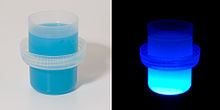- Optical brightener
-
Optical brighteners, optical brightening agents (OBAs), fluorescent brightening agents (FBAs) or fluorescent whitening agents (FWAs) are dyes that absorb light in the ultraviolet and violet region (usually 340-370 nm) of the electromagnetic spectrum, and re-emit light in the blue region (typically 420-470 nm). Fluorescent activity is a short term or rapid emission response, unlike phosphorescence, which is a delayed emission. These additives are often used to enhance the appearance of color of fabric and paper, causing a "whitening" effect, making materials look less yellow by increasing the overall amount of blue light reflected.[1]
Properties
The most common classes of chemicals with this property are the stilbenes and older, non-commercial fluorescent chemical such as umbelliferone, which absorb energy in the UV portion of the spectrum and re-emit it in the blue portion of the visible spectrum. A white surface treated with an optical brightener can emit more visible light than that which shines on it, making it appear brighter. The blue light emitted by the brightener compensates for the diminishing blue of the treated material and changes the hue away from yellow or brown and toward white.
There are approximately 400 brightener types listed in the Color Index, but less than 90 are actually produced commercially and only a handful are commercially important. Generically, the C.I. FBA number can be assigned to a specific molecule, however, some are duplicated, since manufacturers apply for the index number when they produce it. The global OBA production for paper, textiles and detergents is dominated by just a few di- and tetra-sulfonated triazole-stilbenes and a di-sulfonated stilbene-biphenyl. These are subject to fading when exposed long term to UV, due to the formation of optically inactive stilbene cis-isomers found at the center of the molecule. Exposed to gases and especially oxygen they will fade too, like most dye colorants. All brighteners have extended conjungation and/or aromaticity, allowing for electron movement. Some non-stilbene brighteners are used in more permanent applications such as whitening synthetic fiber.
Basic class types of brighteners include:
- Triazine-stilbenes (di-, tetra- or hexa-sulfonated)
- Coumarins
- Imidazolines
- Diazoles
- Triazoles
- Benzoxazolines
- Biphenyl-stilbenes
Brighteners can be "boosted" by the addition of certain polyols like high molecular weight polyethylene glycol or polyvinyl alcohol. These additives increase the visible blue light emissions significantly. Brighteners can also be "quenched". Too much use of brightener will often cause a greening effect as emissions start to show above the blue region in the visible spectrum. Besides the formation of cis isomer in stilbene-containing brighteners (only the trans isomer is optically active), continued exposure to UV-containing light will actually cleave the molecule and start the process of degradation.
Common uses
Brighteners are commonly added to laundry detergents to replace whitening agents removed during washing and to make the clothes appear cleaner. Optical brighteners have replaced bluing which was formerly used to produce the same effect. Some brighteners can cause allergic reactions when in contact with skin, depending on the individual.
Brighteners are used in many papers, especially high brightness papers, resulting in their strongly fluorescent appearance under UV illumination. Paper brightness is typically measured at 457 nm, well within the fluorescent activity range of brighteners. Paper used for banknotes does not contain optical brighteners, so a common method for detecting counterfeit notes is to check for fluorescence.
Optical brighteners have also found use in cosmetics. One application is to formulas for washing and conditioning grey or blonde hair, where the brightener can not only increase the luminance and sparkle of the hair, but can also correct dull, yellowish discoloration without darkening the hair. Some advanced face and eye powders contain optical brightener microspheres that brighten shadowed or dark areas of the skin, such as "tired eyes".
A side effect of textile optical whitening is to make the treated fabrics more visible with Night Vision Devices than non-treated ones. This may or may not be desirable for military or other applications. Optically brightened paper is often not useful in exacting photographic or art applications, since the whiteness decreases with time.
Enduses of optical brighteners include:
- Detergent whitener (instead of bluing agents)
- Paper brightening (internal or in a coating)
- Fiber whitening (internal, added to polymer melts)
- Textile whitening (external, added to fabric finishes)
- Color-correcting or brightening additive in advanced cosmetic formulas (shampoos, conditioners, eye makeup)
References
- ^ Eduard Smulders, Wolfgang Rybinski, Eric Sung, Wilfried Rähse, Josef Steber, Frederike Wiebel, Anette Nordskog, "Laundry Detergents" in Ullmann’s Encyclopedia of Industrial Chemistry 2002, Wiley-VCH, Weinheim. doi:10.1002/14356007.a08_315.pub2
Categories:- Fluorescent dyes
- Cleaning product components
- Luminescence
- Papermaking
Wikimedia Foundation. 2010.

